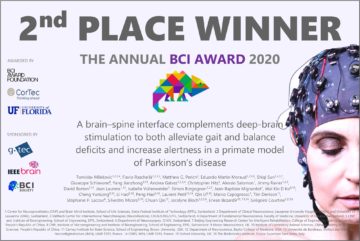
Annual BCI Award : BSI project wins 2nd place
 The PD BSI project (co-PI : Erwan Bezard) has won the second place at the 2020 BCI Award competition:
The PD BSI project (co-PI : Erwan Bezard) has won the second place at the 2020 BCI Award competition:Project
A brain–spine interface complements deep-brain stimulation to both alleviate gait and balance deficits and increase alertness in a primate model of Parkinson’s disease
Tomislav Milekovic1,2,3,4, Flavio Raschellà1,2,3,5, Matthew G. Perich2, Eduardo Martin Moraud1,2,3,6, Shiqi Sun1,2,3,7, Giuseppe Schiavone8, Yang Jianzhong9,10, Andrea Galvez1,2,3,4, Christopher Hitz1, Alessio Salomon1, Jimmy Ravier1,2,3, David Borton1,11, Jean Laurens1,12, Isabelle Vollenweider1, Simon Borgognon1,2,3, Jean-Baptiste Mignardot1, Wai Kin D Ko9,10, Cheng YunLong9,10, Li Hao9,10, Peng Hao9,10, Laurent Petit13,14, Qin Li9,10, Marco Capogrosso1, Tim Denison15, Stéphanie P. Lacour8, Silvestro Micera5,16, Chuan Qin10, Jocelyne Bloch1,2,3,6, Erwan Bezard9,10, 13,14, Grégoire Courtine1,2,3,6
1 Center for Neuroprosthetics (CNP) and Brain Mind Institute, School of Life Sciences, Swiss Federal Institute of Technology (EPFL), Switzerland
2 Department of Clinical Neuroscience, Lausanne University Hospital (CHUV) and University of Lausanne (UNIL), Switzerland
3 Defitech Center for Interventional Neurotherapies (NeuroRestore), CHUV/UNIL/EPFL, Switzerland
4 Department of Fundamental Neuroscience, Faculty of Medicine, University of Geneva, Switzerland
5 CNP and Institute of Bioengineering, School of Engineering, EPFL, Switzerland
6 Department of Neurosurgery, CHUV, Switzerland
7 Beijing Engineering Research Center for Intelligent Rehabilitation, College of Engineering, Peking University, People’s Republic of China
8 CNP, Institute of Microengineering and Institute of Bioengineering, School of Engineering, EPFL, Switzerland
9 Motac Neuroscience, UK
10 Institute of Laboratory Animal Sciences, China Academy of Medical Sciences, People’s Republic of China
11 Carney Institute for Brain Science, School of Engineering, Brown University, USA
12 Department of Neuroscience, Baylor College of Medicine, USA
13 Université de Bordeaux, Institut des Maladies Neurodégénératives (IMN), UMR 5293, France
14 CNRS, IMN, UMR 5293, France
15 Oxford University, UK
16 The BioRobotics Institute, Scuola Superiore Sant’Anna, Italy
Abstract
More than 90% of individuals with Parkinson’s disease (PD) suffer from locomotor disturbances that affect their quality of life and increase comorbid conditions. In the late-stage of PD, these deficits respond poorly to commonly available therapies such as sensory cuing, dopamine replacement strategies and deep brain stimulation (DBS). Gait and balance deficits are in part due to the disruption of the communication between the brain and spinal cord resulting from the depletion of dopaminergic and cholinergic circuits located in the basal ganglia and brainstem. We previously engineered a wireless brain–spine interface (BSI) that restored this communication after spinal cord injury (SCI). Here, we optimised this BSI for PD and show that this neurotechnology alleviates gait and balance deficits in the 1–methyl–4–phenyl–1,2,3,6–tetrahydropyridine (MPTP) nonhuman primate model of PD4. Macaque monkeys were implanted with intracortical microelectrode arrays into the left and right leg primary motor cortex (MI) to record neural activity, and bipolar electrodes into leg muscles to monitor electromyographic signals. The severe loss of midbrain dopaminergic neurons induced pronounced gait and balance impairments that replicated the axial deficits and bradykinesia observed in humans with late-stage PD. However, these impairments did not disrupt the encoding of basic and skilled locomotion in MI neuronal ensembles. Preservation of cortical dynamics allowed highly accurate decoding of locomotor intents from MI activity. Projection of muscle activity onto the location of motor neuron pools in the spinal cord showed that walking involves the sequential activation of spatially–restricted regions, and that this activation is altered when PD symptoms appear. To restore the natural dynamics of motor neurons, we designed spinal implants that targeted the posterior roots projecting to the spinal cord regions containing these motor neurons. We then developed a multi–class asynchronous decoder that linked MI modulation to electrical spinal cord stimulation protocols reproducing the spatiotemporal sequence of motor neuron activity during walking. This BSI instantly reduced freezing of gait and improved the walking speed, gait quality, posture and locomotor dexterity. The BSI could operate concurrently to DBS of the subthalamic nucleus (STN), which mediated synergistic improvements of gait and alertness. We will now test the therapeutic efficacy of this combined strategy in people with PD using clinically validated neurotechnologies.
About BCI-award
https://www.bci-award.com/2020
Last update 15/10/20
